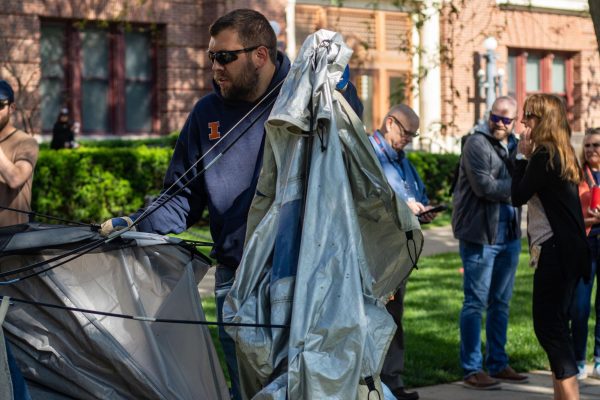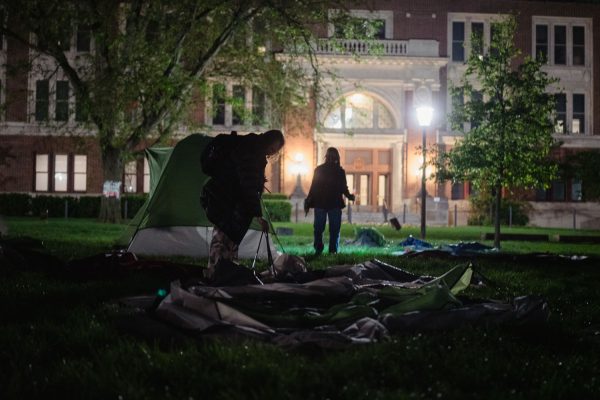The sleepy student sits in the large lecture hall at 8 a.m. as the professor discusses the arcane biology of the Amazon triple-spotted frog. Out comes a pen targeting his desk. With a flourish he adds his revelation of the day: “This class is boring.”
Although this example is only hypothetical, this scene actually plays itself out countless times a year across the University campus and at neighboring bars and restaurants. Walls, benches, desks, bathrooms and practically any flat surface becomes the palette of the graffiti artist.
While students generally do not have the stereotypical image of a graffiti artist — a dark hooded sweatshirt, a bag full of spray paint, ninja-like appearance and abilities — they are committing vandalism every time they add graffiti to classrooms. Graffiti is so prevalent around campus, inside and outside of University buildings, that it may just seem like part of the school’s tradition. However, graffiti is illegal when it involves state-owned property.
One University building that has its share of graffiti is Gregory Hall.
“Graffiti is so common nowadays that it’s almost like you expect to see it,” said Sheri Chambers, office support specialist of the Department of Journalism in Gregory Hall. “A lot of the graffiti is left up until it wears away with time. I don’t really pay attention to it or notice it as much unless it’s something that really catches my eye.”
Get The Daily Illini in your inbox!
A lot of the graffiti written is not offensive or harmful. Many of the messages are personal advertisements for friends, such as wishing them happy birthday or congratulating them on getting into a fraternity.
While graffiti in classrooms may slide by unpunished, a graffiti artist who marks the outside of University buildings could get more than they bargained for, including a trip to the Champaign County jail, according to Lt. V.G. “Skip” Frost, captain of operations of the University Police. In some cases, graffiti artists were arrested and needed to post bond to be released.
One piece of graffiti seen around campus is a stencil of a penguin, accompanied with the initials P.D., created by the graffiti artist, Paradox. Students can see these penguins on buildings, sidewalks and even the interstate. While the penguins may be interesting to look at, the University Police do not view them as street art. Any form of graffiti on University-owned property is considered vandalism and criminal defacement.
“Graffiti artists may not have any evil intent, but the cost of cleaning up the graffiti can be thousands of dollars, near felony amounts,” Lt. Frost said. “When graffiti is written on buildings, we have to get crews to the site to clean it up using pressure washers. There are so many hidden costs. It’s similar to mud sliding. People think it’s just harmless fun, but once they are done, crews need to go out and replace that sod.”
John Collins, operations supervisor of the Urbana Public Works Department, also views any form of graffiti as a huge hindrance.
“When graffiti is written on the front of stop signs, we need to replace them because the graffiti ruins the reflectivity of the signs. The stop signs cost around $35 to $40 a piece, and end up being a big expense.”
The graffiti on campus has also caused grief for many citizens in Champaign-Urbana.
“People view graffiti as victimless crime, but it’s not,” Frost said. “It affects private homeowners, the owners of buildings in Campustown, the faculty who work in the University buildings. There clearly is a victim, and they need the problem addressed.”
While graffiti is not permitted on University property, many restaurants in Campustown allow their customers to add names and personal messages on their furniture. Unlike the problematic graffiti written on buildings and sidewalks, the graffiti in certain restaurants is welcomed and encouraged.
Murphy’s Pub, an Irish bar located on Green Street, is known for its history of wooden tables engraved with generations of customers’ names. Most of the messages, which are carved using keys or knives, follow the template of ‘So and so was here,’ or ‘So and so loves so and so.’ Many have left memorable and intricate designs, displaying true creativity and craftsmanship.
“The engravings definitely add to the atmosphere of the restaurant,” said Dave Stillwell, manager of Murphy’s Pub. “When people come back fifteen years later, they really enjoy seeing their names still written on the tables, and being able to show their names to their kids.”
Customers’ appreciation for this legendary tradition was openly displayed when Murphy’s Pub added an expansion to the restaurant in October 2009.
“We opened up a new portion of the bar on a Friday night. By Saturday morning, all of the new tables were covered in engravings of peoples’ names and initials,” Stillwell said.
To keep the tables in good condition, they cover the tables with a coating of epoxy. The bar still has most of its original furniture with its forty years of memories, while some of it had to be replaced.
Murphy’s Pub is not the only place in Campustown known for promoting customer participation in shaping the character of the restaurant. Stone Baked Pizzeria, previously named Second Story Pizza, located on the second story of 901 S. Fourth Street, is also known for the graffiti that aligns its orange and blue walls. The walls along the stairway are decorated in handwritten scrawls of signatures, messages and illustrations from the customers of Stone Baked Pizzeria.
The main wall at the top of the stairway, which displays a large painted letter ‘I,’ is one of the pizza place’s popular signing spots. One humorous comment read, ‘I have free puppies!’ and included a phone number to contact. However, adding phone numbers on the wall is discouraged, and the owners cross them off for safety and privacy reasons.
Matt Bailey, an employee at Stone Baked Pizzeria, said the tradition did not really have a clear beginning, but it has been a defining characteristic of the pizza place since before Bailey started working there three years ago.
“The owners used to paint over the graffiti every year, but they eventually just gave up because people kept adding to it,” Bailey said. “People can write anywhere. They bring their own utensils, and literally put anything up.”
Bailey said the graffiti, ranging from interesting to hilarious, adds to the pizza-eating experience.
Ultimately, the legality of graffiti completely depends on the environment and the circumstances.
“People always make comments when they come up the stairs to get their pizza,” Bailey said. “The graffiti makes things fun and gives everyone in line a laugh.”







